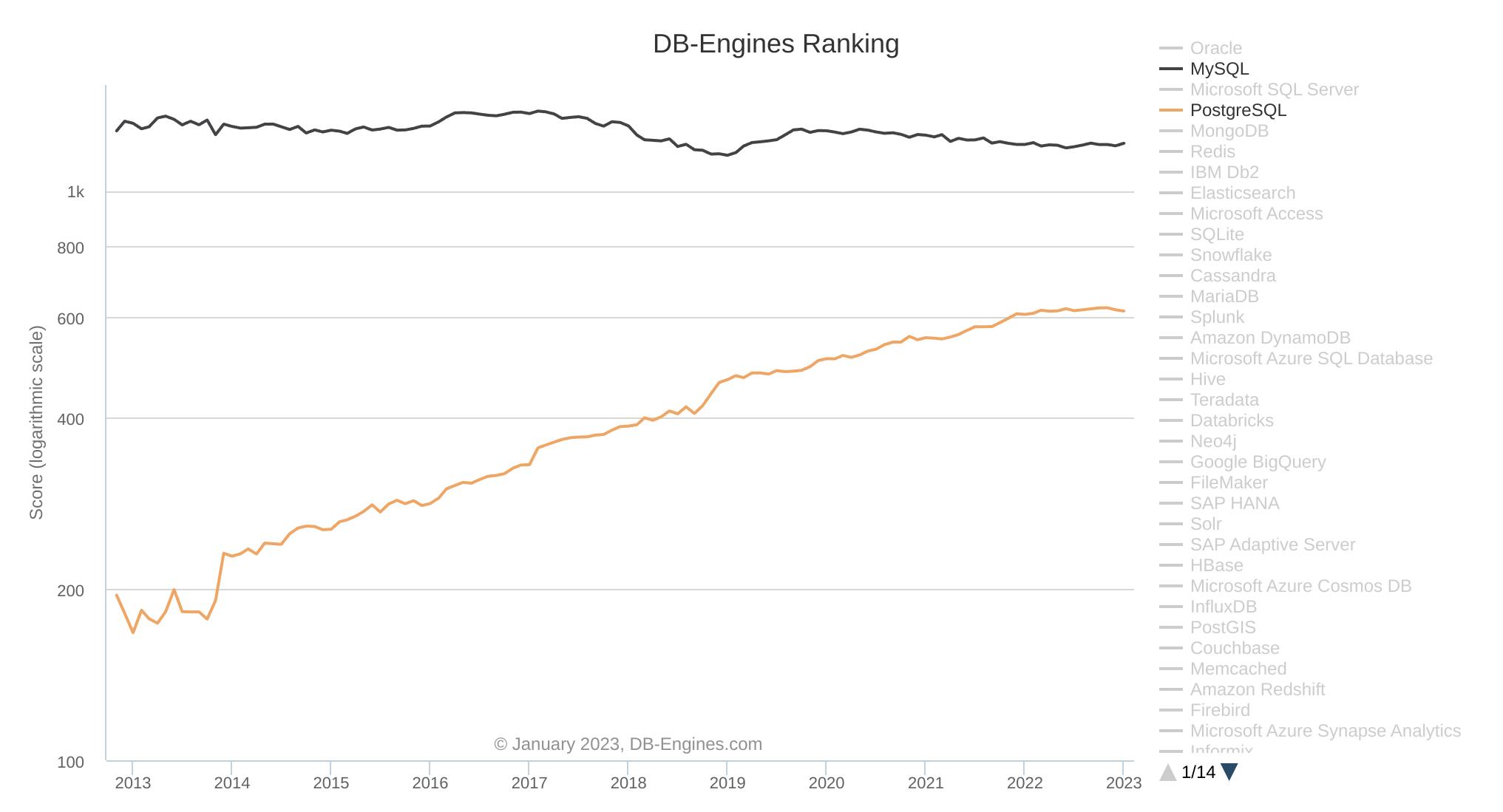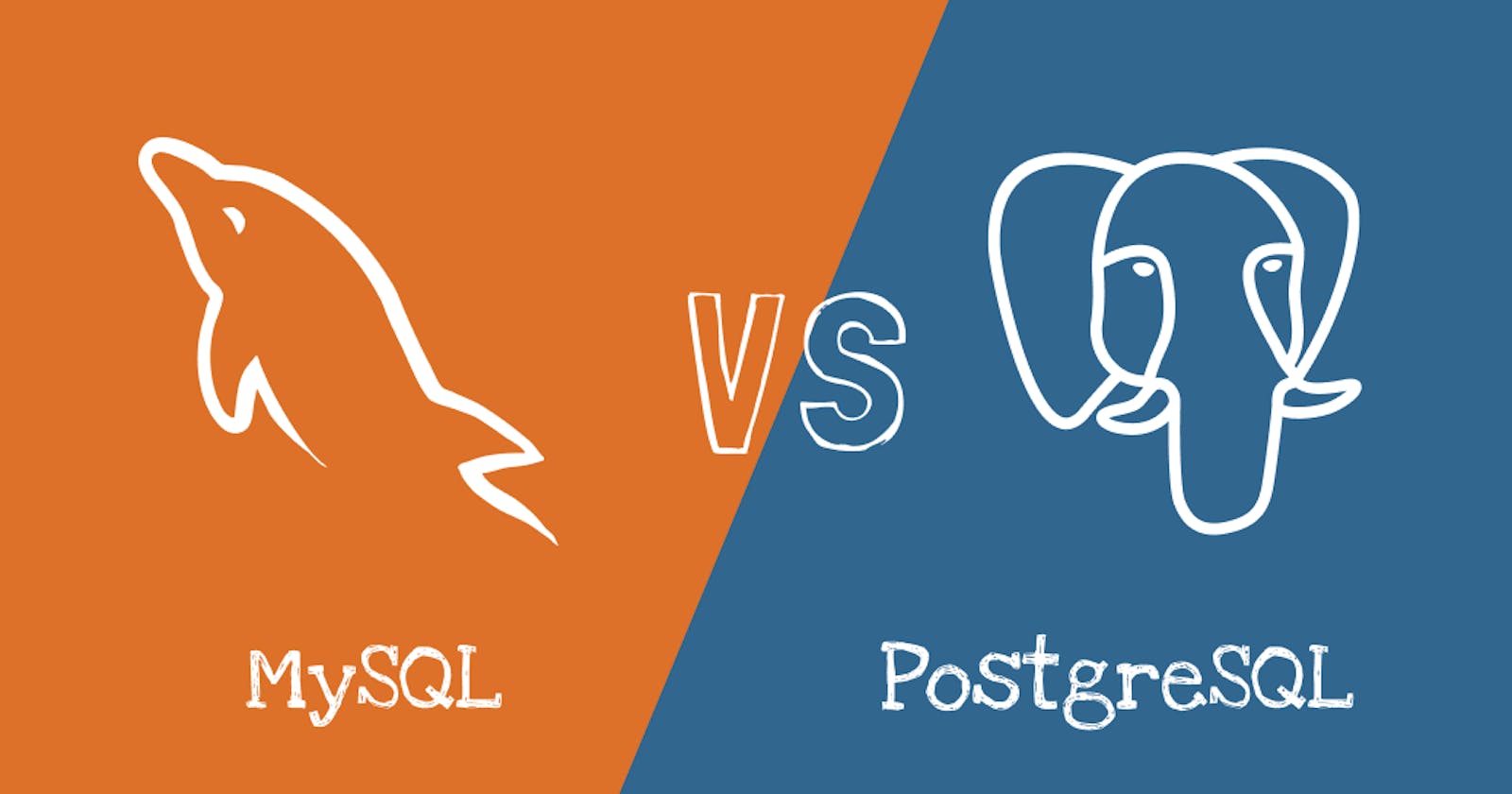When it comes to choosing a relational database management system (RDBMS), two popular options are PostgreSQL and MySQL. Both have been around for decades and have proven to be highly reliable, secure, and scalable. However, they have different strengths and weaknesses that make one more suitable for certain use cases than the other. In this article, we will compare PostgreSQL and MySQL to help you make an informed decision in 2023.
History and Development
PostgreSQL was first released in 1996 and has since become a widely used open-source RDBMS. It is known for its strong adherence to SQL standards, its robust feature set, and its focus on data integrity and security.
MySQL, on the other hand, was first released in 1995 and has been widely used for web-based applications due to its high performance and ease of use. Over the years, MySQL has been acquired by Oracle and has evolved into a commercial database management system.
Features
PostgreSQL and MySQL both offer a wide range of features as relational database management systems, but there are some key differences between the two:
Data Types: PostgreSQL supports a wider range of advanced data types, including arrays, hstore (a key-value store), and JSONB (binary JSON), which provide more flexible and efficient data storage options. MySQL, on the other hand, has a more limited set of data types and is geared towards simpler, web-based applications.
Geospatial Support: PostgreSQL has strong support for geospatial data, including a rich set of data types, functions, and operators for handling geographic data. MySQL, while it has some geospatial support, is not as robust in this area.
Indexing: In MySQL, the default index type is B-tree, which is well-suited for most use cases. PostgreSQL has a more advanced indexing system compared to MySQL, including support for B-tree, GiST (Generalized Search Tree), and GIN (Generalized Inverted Index) indexes. These provide more options for optimizing query performance and data retrieval.
Replication: Both PostgreSQL and MySQL support database replication, but the methods and options for replication differ between the two. PostgreSQL supports multi-master replication, while MySQL primarily supports master-slave replication. A new replication model called Group Replication has been recently introduced by MySQL, but it is still a relatively new feature with some limitations.
Transactions: Both PostgreSQL and MySQL InnoDB utilize MVCC (Multi-Version Concurrency Control) for handling concurrent access to data. However, PostgreSQL offers advanced transaction management features such as transaction isolation levels, atomic transactions, and savepoints. In contrast, MySQL's transaction management options are more limited. For applications that require high concurrency or complex transaction logic, PostgreSQL may be a better choice.
Stored Procedures: Both PostgreSQL and MySQL support stored procedures, but the language and functionality of stored procedures differ between the two. PostgreSQL supports stored procedures written in a variety of languages, including PL/pgSQL, PL/Tcl, PL/Perl, and more. MySQL, alternatively, primarily supports stored procedures written in SQL.
Extensions: PostgreSQL has a robust extension framework that allows developers to add custom functionality and extend the core features of the database. MySQL, while it has some support for extensions, does not have the same level of extensibility as PostgreSQL.
Change Data capture.
MySQL binary logs and PostgreSQL Write-Ahead Logs (WALs) are both used for Change Data Capture (CDC) in their respective databases. However, there are differences in how they are used and the features they offer.
MySQL binary logs contain a record of all changes made to the database, including the statements executed and the data affected. CDC in MySQL can be implemented using binary logs to track changes to the database. This approach provides a detailed record of all changes made to the database, which can be useful for replicating data to other systems, auditing changes to the database, or for real-time data analysis.
PostgreSQL Write-Ahead Logs (WAL) is a key component of PostgreSQL's transaction management system. They provide a record of all changes made to the database and are used to ensure data consistency and reliability in the event of a crash or other failure. CDC in PostgreSQL can be implemented using the WAL logs to track changes to the database. This approach provides a record of all changes made to the database in real time, which can be useful for replicating data to other systems or for real-time data analysis.
DBConvert Streams is a software that can read the transaction logs of both MySQL and PostgreSQL and transform the records to another dialect, making it suitable for heterogeneous database replication in real-time. This software offers a flexible and comprehensive solution for replicating data between different databases, regardless of the source and target databases being used.
By using DBConvert Streams, you can capture changes made to your source database in real-time and replicate them to your target database, ensuring that your data is always up-to-date and consistent.
Performance
MySQL is known for its high performance and ability to handle large amounts of data. It has been optimized for read-heavy workloads and has a fast indexing system that helps improve query performance. However, when mixed with write operations, it can suffer from concurrency issues, such as lock contention, which can result in slow performance. This is due to its use of table-level locks, which block all operations on a table when a write operation is being performed. To address this, MySQL has introduced new storage engines, such as the InnoDB engine, which support row-level locking and provide improved concurrency for mixed workloads. Additionally, the recent development of the high-performance storage engine, MyRocks, has further improved MySQL's ability to handle write-intensive workloads.
PostgreSQL is designed to be more versatile, handling both read-heavy and write-heavy workloads, but with slightly lower performance compared to MySQL, which is optimized for read-heavy workloads. However, PostgreSQL has improved its performance in recent versions, especially when it comes to complex queries and data processing.
Additionally, PostgreSQL has a more advanced indexing system compared to MySQL, which can improve performance for complex queries. PostgreSQL also supports advanced data types, like arrays and JSONB, which can result in more efficient data storage and retrieval.
Ultimately, the performance of both PostgreSQL and MySQL will depend on various factors, such as hardware, data size, and query complexity. When it comes to choosing between the two, it is important to consider the specific requirements of your application and to conduct performance testing with your data and workloads to determine the best fit.
Scalability
Both MySQL and PostgreSQL can scale, but they have different strengths and weaknesses when it comes to scalability.
MySQL is often favored for its horizontal scalability, which means it can be scaled out by adding more nodes to a database cluster. This makes it ideal for web-scale applications that need to handle a large number of concurrent connections. MySQL also supports multiple storage engines, including InnoDB, which provides support for row-level locking and is well-suited for transactional workloads.
PostgreSQL, on the other hand, is known for its vertical scalability, which means it can handle larger amounts of data and processing power by adding more resources like memory and CPU to a single node. It also supports horizontal scaling through technologies like sharding, which enables you to split large datasets across multiple nodes. PostgreSQL is favored for applications that require complex queries and transactions, as well as for data warehousing and business intelligence workloads.
In terms of scalability, it's important to consider the specific requirements of your application. If you need to handle a large number of concurrent connections and need horizontal scalability, MySQL may be a better choice. However, if you require complex transactions and queries, or if you need to scale up by adding more resources to a single node, PostgreSQL may be a better option.
Cost
In 2023, it is still true that PostgreSQL is fully open-source and community-driven, whereas MySQL has a more complex history concerning licensing. MySQL was initially developed as a commercial product by the company MySQL AB, with both free and paid versions available. The acquisition of MySQL AB by Oracle in 2010 raised some concerns among developers about the future of its open-source status. However, there are several open-source forks of the original MySQL, including MariaDB and Percona, which have helped to mitigate these concerns to some extent.
When to Use MySQL?

Although PostgreSQL has many advanced features and is often considered to be a more advanced and sophisticated database management system than MySQL, it is not without its drawbacks. Some of the common drawbacks of PostgreSQL include:
Despite its advanced features and capabilities, PostgreSQL has yet to reach the level of popularity and widespread use of MySQL. This has resulted in a smaller number of third-party tools and a lesser number of experienced developers or database administrators in the PostgreSQL ecosystem.
Due to its advanced features, PostgreSQL can be more complex to set up and manage than MySQL, making it more suitable for experienced database administrators and developers.
In certain use cases, PostgreSQL can be slower than MySQL due to its more complex architecture and features.
PostgreSQL can require more resources than MySQL, particularly in terms of memory and CPU usage.
While PostgreSQL is open-source, the cost of implementation and maintenance can still be high due to its advanced features and increased resource requirements.
PostgreSQL forks a new process for each new client connection and this can allocate a significant amount of memory, typically around 10 MB per connection. However, it is worth noting that this architecture is designed to provide improved security and isolation between different clients and is generally considered a trade-off for better performance, reliability, and scalability.
PostgreSQL is designed with extensibility, standards compliance, scalability, and data integrity as priorities, and sometimes these features can result in a decrease in performance compared to MySQL, especially in simple read-heavy workloads. However, it's important to note that the exact performance difference depends on various factors, such as the size of the data, the complexity of the queries, and the hardware being used.
These factors need to be taken into consideration when choosing between PostgreSQL and MySQL for a particular use case. It's important to weigh the benefits and drawbacks of each database management system and choose the one that best fits the needs of the company.
Which migration is more common: from MySQL to PostgreSQL or from PostgreSQL to MySQL?
The frequency of migration between MySQL and PostgreSQL varies and is dependent on individual organizations' needs and requirements. Some organizations may migrate from MySQL to PostgreSQL to take advantage of its advanced features, better SQL compliance, and open-source compatibility. PostgreSQL is also more popular in certain industries, such as financial services, government, and data warehousing, where performance, scalability, and security are important considerations.
On the other hand, other companies may migrate from PostgreSQL to MySQL for its simplicity, wide community of support, and lower cost of implementation.
It appears that the trend of migration is towards moving from MySQL to PostgreSQL based on various indicators. These indicators suggest that there is a greater number of people shifting from MySQL to PostgreSQL compared to the reverse.
Availability of migration tools: There are a large number of open-source and commercial migration tools available to assist in migrating data from MySQL to PostgreSQL, while there are fewer tools to migrate data from PostgreSQL to MySQL.
Online resources: There is greater availability of online tutorials and resources on migrating from MySQL to PostgreSQL, compared to the other way around.
Community growth: The PostgreSQL community has been growing faster than the MySQL community, indicating a growing interest in using PostgreSQL over MySQL.
Open source contributions: The number of open source contributions to PostgreSQL is increasing, indicating that more people are investing time and resources into the technology and finding it useful for their needs.
Enterprise adoption: Some of the world's largest and most data-intensive organizations, such as Cisco, Fujitsu, and the U.S. Federal Aviation Administration (FAA), have publicly stated that they have moved from MySQL to PostgreSQL.
User surveys: Industry analysts and database experts have conducted surveys that suggest that more people are considering or planning to switch from MySQL to PostgreSQL.
Please note that these facts only indicate that more migrations happen from MySQL to PostgreSQL than the other way around, and it might not be true in all cases.
Conclusion.
Both PostgreSQL and MySQL are robust relational database management systems with unique features and limitations. The decision to use one over the other should be based on the specific requirements of a project, such as the nature and amount of data, the intricacy of queries, and performance and scalability needs. As both PostgreSQL and MySQL are set to undergo further advancements in 2023, it is crucial to stay updated on their recent developments.
In addition, it's worth mentioning that there are tools like DBConvert Studio that can help with migrating data between MySQL and PostgreSQL in either direction. These tools can simplify the process of transferring data from one database to another, which can be especially useful if you are considering a switch from one system to the other.

